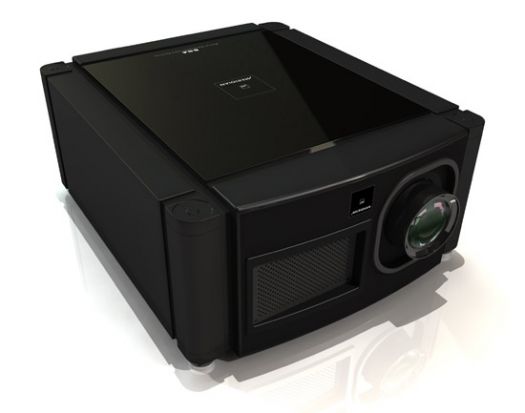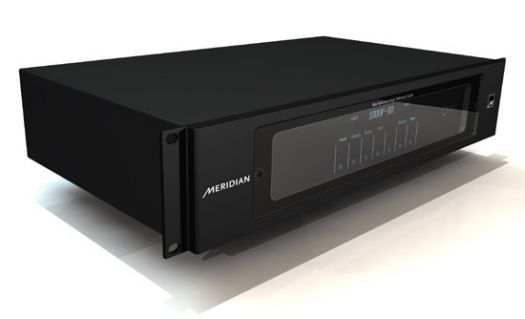Meridian Unveils the Ten Megapixel 810 Reference Video System
As with digital cameras, so goes the battle with home theater projectors - the race is on to pack as many pixels as possible into a projector's light engine. Theoretically more pixels are better, because they give you more detail in your image. And when you blow up an image to 150 inches diagonal or more, those extra pixels come in handy.
But as with digital cameras, the absolute number of pixels is not necessarily the most important element in picture quality. Color accuracy, deep black level reproduction (contrast), brightness and grey scale uniformity all contribute to overall picture quality and the ability for a projector to create a pleasing, realistic image at any screen size. If you can manage to do the above things right and combine this with an ultra-detailed light engine, then you have a winner. And that's just what Meridian believes they have in the new Meridian 810 Reference Video System.
At a press conference and demo in New York yesterday, we saw the unveiling of the rather plain-looking black box, which promises to pack a picture-perfect punch within its unassuming exterior. Expected to ship in Q3 of this year, the 810 projector and processor system combines a 4096x2400 3-chip D-ILA (Digital Image Light Amplification) module with a bright PKI Xenon light, and cutting edge video processing from Marvell to create a projection system that should satisfy even the most demanding home theater aficionado (or theater owner, as the case may be).

The projector comes packaged with your choice of a long, short, or medium-throw lens as well as a motorized 2.35:1 anamorphic lens assembly for fixed height ultra-wide screen installations. A "Very Short Throw" option allows the projector to be used in rear projection or simulator applications. All packages also include the 810 Reference Video Scaler which connects to the projector with four parallel DVI-D cables each carrying one quadrant of the image. These four parts are seamlessly stitched back together by the projector to display one integrated full resolution image. Any of these packages will set you back a cool $185,000.
The quoted specs are impressive: 4,000 Lumens of brightness and a native contrast ratio of 10,000:1 But it's the pixel count that really sets this projector apart from the competition. While JVC masks out the top and bottom of this 4Kx2K+ D-ILA light panel using only the "sweet spot" in the center for its own implementation (realizing an effective 4096x2048 resolution), Meridian actually uses the entire panel at 4096x2400 pixels for a total resolution that comes in at just under ten megapixels (9,830,400 pixels to be precise). They are able to do this only after four or more days of hand calibration to each unit which involves extensive testing of the entire projected area for color, brightness and grey scale uniformity, and sometimes extensive re-writing of the lookup tables used by the light engine to map out the projected image.
What source could possibly take advantage of all these pixels? Today? Virtually nothing. Even the mighty 1080p Blu-ray Disc only comprises a mere 2 million pixels. So Meridian had to find a way of taking today's sources, from 480i up to 1080p and enlarging them to the full 10 Megapixels of detail without exposing their less detailed origins. They've done this by partnering with IC maker Marvell whose Qdeo processing technology is responsible for blowing up standard definition and high definition sources to the projector's native 4096x2400 pixel resolution.

The Qdeo processor (short for "Quiet Video" as in the opposite of noisy video) has to do a massive amount of real-time computing to interpolate and rebuild the picture detail that is missing when you try to map a 2 megapixel original to a 10 megapixel final image. Effectively 80% of the viewable image is provided by the processor itself. And when you're viewing a standard definition source, the process is even more daunting as 96% of the image is created by the processor from only around 350,000 pixels in the original image. It's a wonder that they can produce any image at all.
So how did it look? Well the demo was marred by a less than ideal screen that they apparently had rented, and which showed up with more folds than an origami chicken. The masking frame was jagged and uneven, there were visible creases every foot or so, and the optical characteristics of the screen itself were less than ideal. But even still, the 1080i and 1080p demo segments they displayed did look promising, with well saturated colors, good black level reproduction and rich detail even in deep dark segments in a 1080i clip from Gladiator.
I think it's too early to tell whether the performance of this system will merit its lofty price tag. We didn't even get to see how it performed on standard definition material. But, based on my experience with previous Meridian projectors, I know it can look better and I'm looking forward to seeing this again at CEDIA Expo in September where I'm sure they'll have a better screen and projection environment, not to mention a projector that is closer to final production than the one shown in New York.
More information available at: